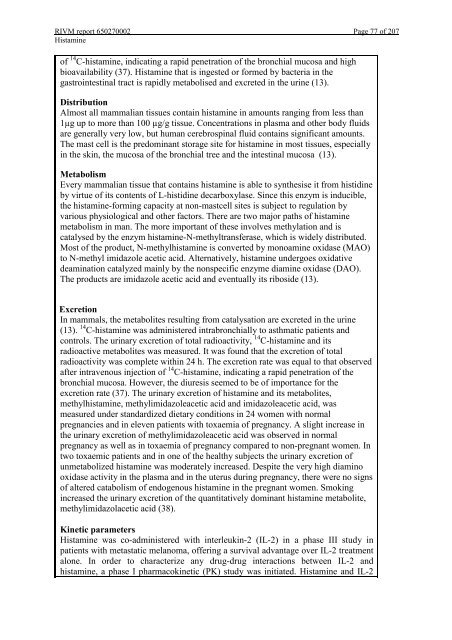The Contribution of cocoa additive to cigarette smoking addiction
The Contribution of cocoa additive to cigarette smoking addiction
The Contribution of cocoa additive to cigarette smoking addiction
Create successful ePaper yourself
Turn your PDF publications into a flip-book with our unique Google optimized e-Paper software.
RIVM report 650270002 Page 77 <strong>of</strong> 207<br />
Histamine<br />
<strong>of</strong> 14 C-histamine, indicating a rapid penetration <strong>of</strong> the bronchial mucosa and high<br />
bioavailability (37). Histamine that is ingested or formed by bacteria in the<br />
gastrointestinal tract is rapidly metabolised and excreted in the urine (13).<br />
Distribution<br />
Almost all mammalian tissues contain histamine in amounts ranging from less than<br />
1µg up <strong>to</strong> more than 100 µg/g tissue. Concentrations in plasma and other body fluids<br />
are generally very low, but human cerebrospinal fluid contains significant amounts.<br />
<strong>The</strong> mast cell is the predominant s<strong>to</strong>rage site for histamine in most tissues, especially<br />
in the skin, the mucosa <strong>of</strong> the bronchial tree and the intestinal mucosa (13).<br />
Metabolism<br />
Every mammalian tissue that contains histamine is able <strong>to</strong> synthesise it from histidine<br />
by virtue <strong>of</strong> its contents <strong>of</strong> L-histidine decarboxylase. Since this enzym is inducible,<br />
the histamine-forming capacity at non-mastcell sites is subject <strong>to</strong> regulation by<br />
various physiological and other fac<strong>to</strong>rs. <strong>The</strong>re are two major paths <strong>of</strong> histamine<br />
metabolism in man. <strong>The</strong> more important <strong>of</strong> these involves methylation and is<br />
catalysed by the enzym histamine-N-methyltransferase, which is widely distributed.<br />
Most <strong>of</strong> the product, N-methylhistamine is converted by monoamine oxidase (MAO)<br />
<strong>to</strong> N-methyl imidazole acetic acid. Alternatively, histamine undergoes oxidative<br />
deamination catalyzed mainly by the nonspecific enzyme diamine oxidase (DAO).<br />
<strong>The</strong> products are imidazole acetic acid and eventually its riboside (13).<br />
Excretion<br />
In mammals, the metabolites resulting from catalysation are excreted in the urine<br />
(13). 14 C-histamine was administered intrabronchially <strong>to</strong> asthmatic patients and<br />
controls. <strong>The</strong> urinary excretion <strong>of</strong> <strong>to</strong>tal radioactivity, 14 C-histamine and its<br />
radioactive metabolites was measured. It was found that the excretion <strong>of</strong> <strong>to</strong>tal<br />
radioactivity was complete within 24 h. <strong>The</strong> excretion rate was equal <strong>to</strong> that observed<br />
after intravenous injection <strong>of</strong> 14 C-histamine, indicating a rapid penetration <strong>of</strong> the<br />
bronchial mucosa. However, the diuresis seemed <strong>to</strong> be <strong>of</strong> importance for the<br />
excretion rate (37). <strong>The</strong> urinary excretion <strong>of</strong> histamine and its metabolites,<br />
methylhistamine, methylimidazoleacetic acid and imidazoleacetic acid, was<br />
measured under standardized dietary conditions in 24 women with normal<br />
pregnancies and in eleven patients with <strong>to</strong>xaemia <strong>of</strong> pregnancy. A slight increase in<br />
the urinary excretion <strong>of</strong> methylimidazoleacetic acid was observed in normal<br />
pregnancy as well as in <strong>to</strong>xaemia <strong>of</strong> pregnancy compared <strong>to</strong> non-pregnant women. In<br />
two <strong>to</strong>xaemic patients and in one <strong>of</strong> the healthy subjects the urinary excretion <strong>of</strong><br />
unmetabolized histamine was moderately increased. Despite the very high diamino<br />
oxidase activity in the plasma and in the uterus during pregnancy, there were no signs<br />
<strong>of</strong> altered catabolism <strong>of</strong> endogenous histamine in the pregnant women. Smoking<br />
increased the urinary excretion <strong>of</strong> the quantitatively dominant histamine metabolite,<br />
methylimidazolacetic acid (38).<br />
Kinetic parameters<br />
Histamine was co-administered with interleukin-2 (IL-2) in a phase III study in<br />
patients with metastatic melanoma, <strong>of</strong>fering a survival advantage over IL-2 treatment<br />
alone. In order <strong>to</strong> characterize any drug-drug interactions between IL-2 and<br />
histamine, a phase I pharmacokinetic (PK) study was initiated. Histamine and IL-2
















